

Normal faults that generally radiate from a central point. They are created by an extensional tectonic regime (
1 vertical), in which the horizontal axes of the effective stresses ellipsoid are equal. Radial fault are also named stretching faults.
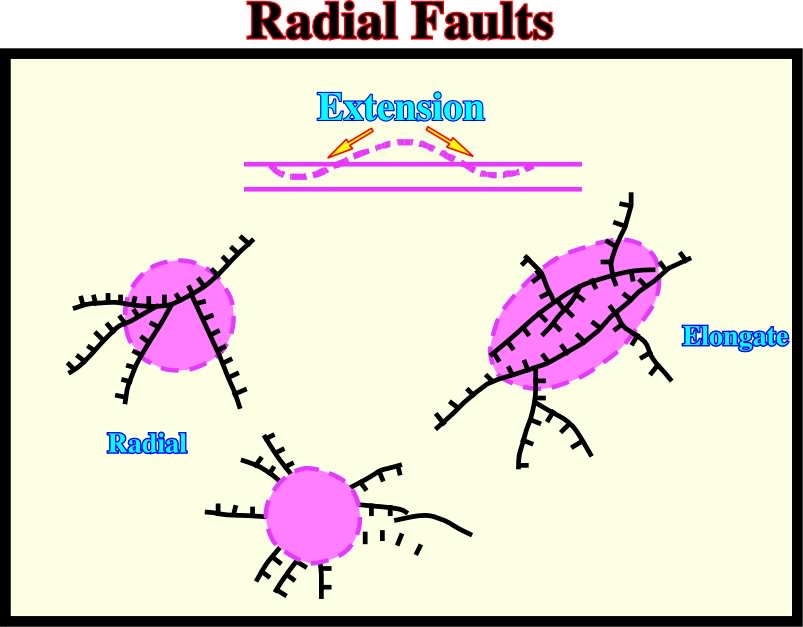
Radial faults are associated mainly with salt domes, shale domes and buried hills. The associated tectonic regime is characterized by a
1 vertical (extension) and
2 =
3, i.e., with a biaxial ellipsoid of effective stresses.
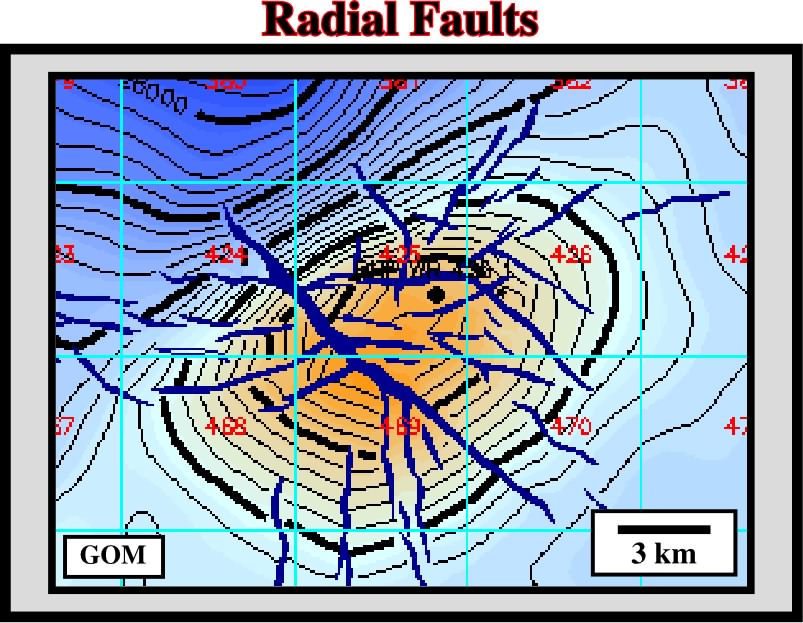
The radial faults recognized in the apex of this domal structure strongly suggest the sediments where lengthened which implies a late extensional tectonic regime. It is possible that a compressional tectonic regime shortened the sediments in a first phase, but it is quite evident that, later, an extensional regime (probably a salt intrusion) took place.
Fault block of allochthonous overburden that have separated to the extent that they no longer rest on their original footwall (the adjoining fault block) and lie entirely on a décollement layer, which typically consists of salt.
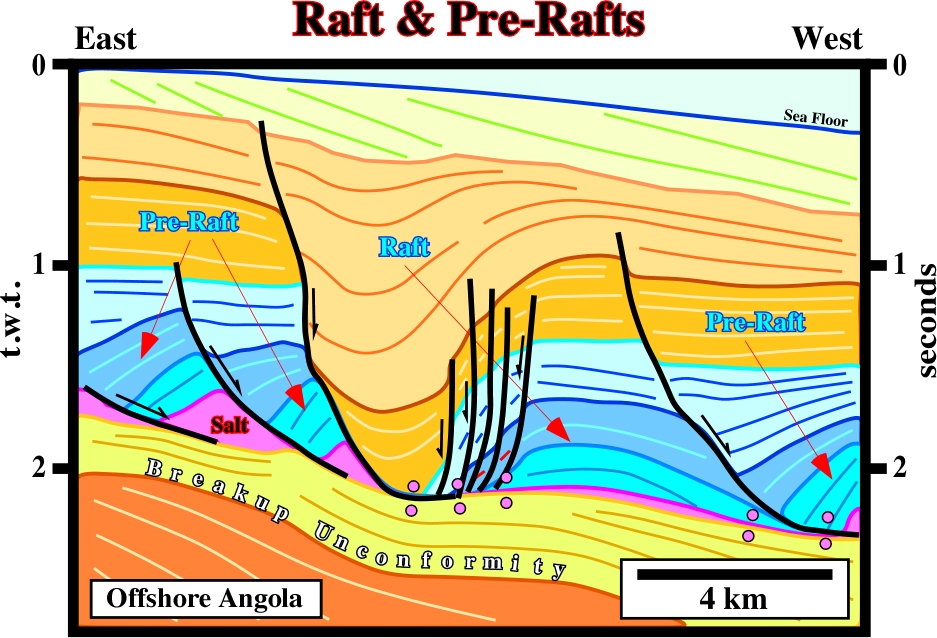
This line clearly illustrates the different between raft and pre-rafts. A salt weld and a thick depocenter induced by a local complete salt evacuation, separates two pre-rafts from a raft. Another pre-raft is recognized seaward. The tectonic disharmony underlining the bottom of the salt is so obvious that, in Angola, the bottom of the salt was erroneously used to separate the stratigraphy into two major intervals: sub-salt strata and post salt strata.
Extreme extension characterized by the opening of deep, synsedimentary grabens and separation of intervening overburden into rafts, which slide downslope on a décollement of thin salt, like a block-glide landslip.
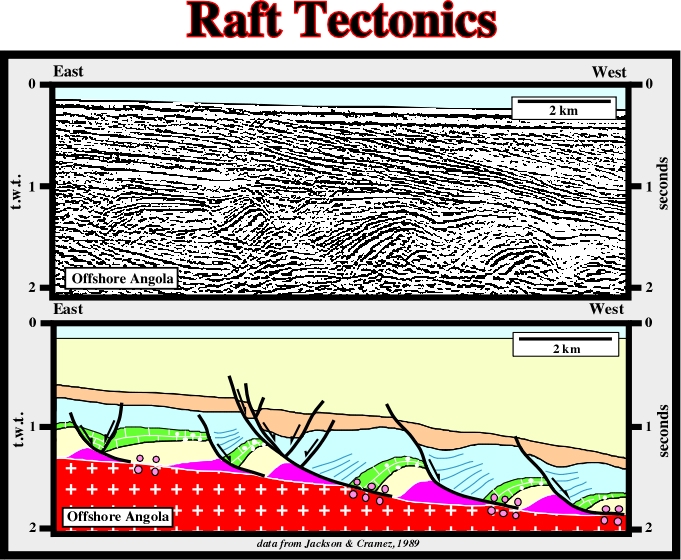
Raft Tectonics was first recognized in Angola onshore by Petrangol's geologists and then by Total's who hypothesize gravity as the main driving mechanism ("Tectonique en Radeau", Burollet, P.F., 1975).
Rate of Rise (Talbot, C. J., 1995)
The vertical flow rate of salt minus dissolution. The rate of rise is represented by R°.
The following rates are the most relevant to salt tectonics: (i) Aggradation rate of overburden (ii) Dissolution rate of salt structure, (iii) Extension rate of overburden or salt, (iv) Lateral injection rate of salt structure,(iv) Progradation rate of overburden,(v) Gross rate of salt flow upward, (vi) Net rate of increase in relief of salt structure and (vii) Shortening rate of overburden or salt.
The hypothesis that a dense fluid overburden having negligible yield strength sinks into a less dense fluid salt layer, displacing it upward. Indeed, a layer of viscous fluid of uniform density overlying a compositionally less-dense layer is unstable. Small perturbations in the horizontal interface become amplified at a rate, represented by an eigenvalue (the special value variable parameter for which the solution of an equation is nontrivial) that depends on the thickness, density, and viscosity of every layer, size of initial perturbation, and time elapse.
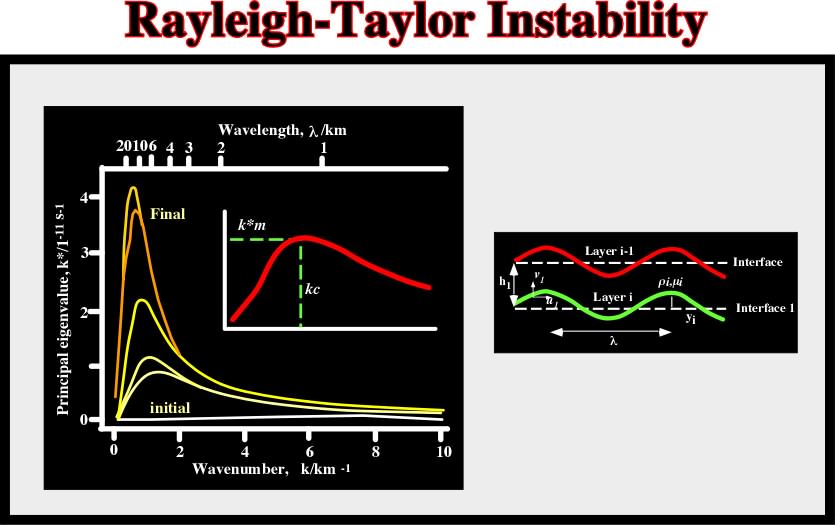
The Rayleigh-Taylor instability, i.e., the hypothesis that a dense fluid overburden having negligible yield strength sinks into a less dense fluid salt layer, displacing it upward, dominate the fluid era of salt tectonics between 1933 and 1898.
A nondimensional number for measuring the vigor of the Raleigh-Taylor instability and its capacity to advert heat.
Term generally used to designate a salt dome developed from an allochthonous salt layer.
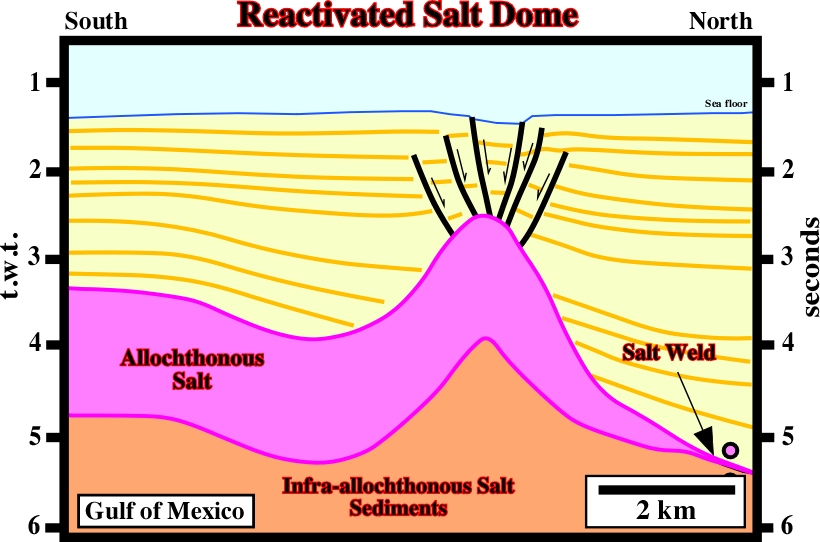
The stretching faults (probably with radial geometry), on the top of the reactivated diapir, affect the sea floor and so strongly suggest the reactivation still is going on. The sediments overlying the salt show a regional northward thickening, which seems to fit with the salt thickness. The upward reactivation of the salt lengthened the sediments obliging them to accommodate the volume conditions.
Deformation of a salt sheet to act as a second-generation diapiric source layer by differential loading or burial below the level of neutral buoyancy. Deformation involves local upwelling of salt and sheet segmentation.

The deformation of the sediments overlying the allochthonous salt created two nice reactivated salt domes as the majority of the salt was evacuated creating a tertiary salt weld.
Regional Elevation (Hossack, J., 1995)
The level to which a key bed will return in the undeformed state. Regional elevation is a key idea used in section balancing.
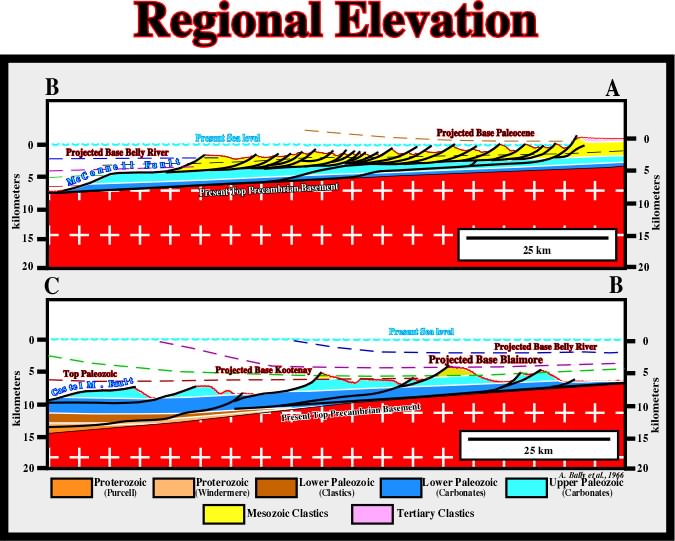
The regional elevations of the stratigraphic different intervals are easily recognized on this restoration (Rocky Mountains) proposed by Bally in 1966.
Seaward displacement of the costal deposits. It happens during decelerated increasing of the relative sea level fall with a terrigeneous influx strong enough to displace seaward the depositional coastal break. A progradational or forestepping interval emphasizes always a regressive interval.

Regressive intervals with their forestepping geometry are well recognized in Tertiary deposits of offshore Brazil as illustrated on this line.
A decreasing or increasing in the space available for sediments. It is created by combination of subsidence and eustasy. A relative sea level fall, if big enough, can create an erosional surface, that is to say, an unconformity (sequence boundary in sequence stratigraphic parlance) and induce turbidite deposits in the deepest part of the basin. A relative sea level rise, in other others; an increasing in accommodation is always required to deposit transgressive or regression sedimentary intervals.
A continuous salt evacuation from the upthrown fault block (footwall) can completely or almost completely destroy a salt roller. Some call relic roller the last stage of salt evacuation from a salt roller.
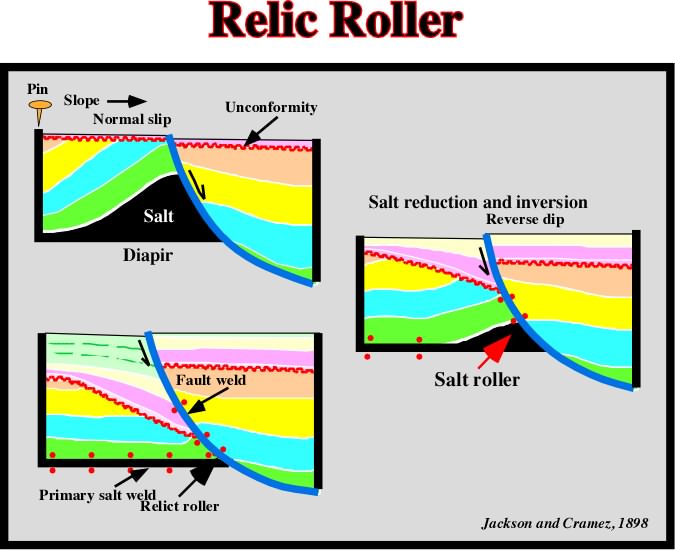
The salt evacuation progressively creates (i) a faulted diapir, (ii) a salt roller, (iii) a relic roller and finally just a primary salt weld and an apparent reverse-fault. The evacuation of the salt from the footwall, as illustrated above, changes, by inversion, a normal listric fault in a normal fault with a reverse geometry, which some call apparent reverse-fault.
An intermodal antiform with a core of salt that may be disconnected or not from the adjacent domes.
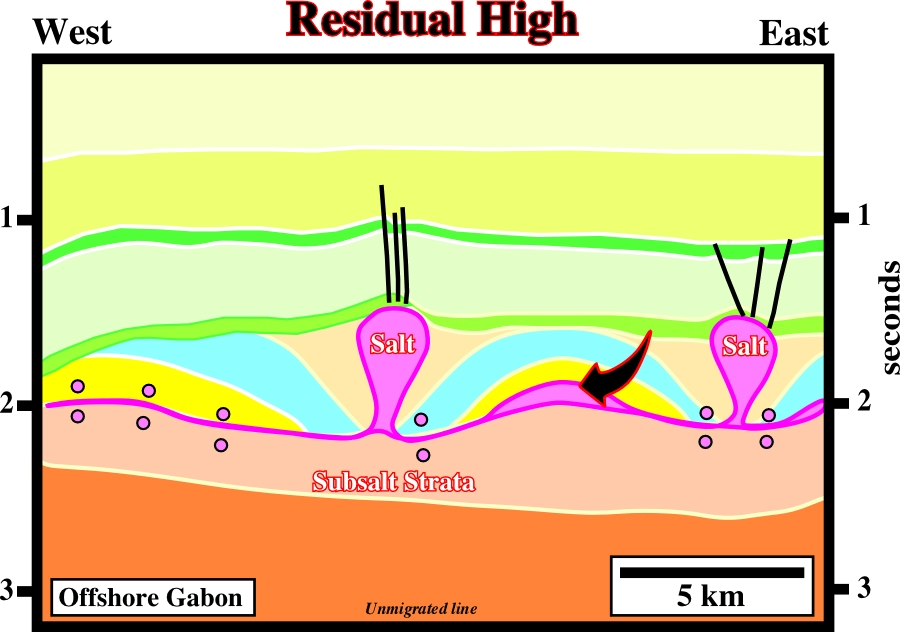
Turtle back structures can have a residual salt high or not as illustrated above. On the left, a primary salt weld took place after a completely salt evacuation. On the contrary, on the right, the salt evacuation was not total, so a residual high still remains in the core of the structure.
See: Palinspastic Section.
See: Backstepping.
A fault on which the hangingwall appears to have moved upward relatively to the footwall. The dip of the fault is usually greater than 45°.
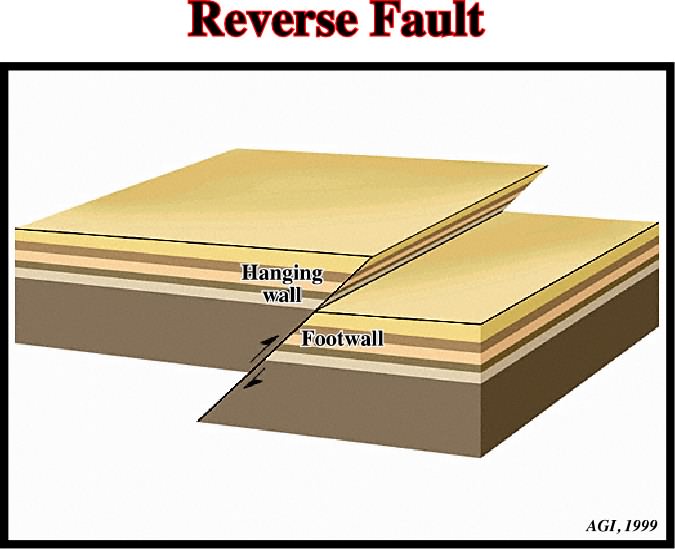
Reverse faults shortened the sediments. They are induced by compressional tectonic regimes, in which the
3 is vertical. They are often associated with cylindrical-folds. The shortening takes place mainly in the hangingwall where folding takes place contributing so to shortening.
Behavior of the overburden under stress. The overburden is commonly modeled as one of two ideal types of behavior: fluid and brittle. Both approximations treat sediments as a continuum. Fluid behavior is modeled as a power-law, time-dependent flow in which shear viscosity decreases as rate of shear increases Brittle behavior of the shallow crust (less than, 8 km deep) has been simulated by experimental rock mechanics.
Elongated, steep-sided elevation of the ocean floor, along which new oceanic crust takes place.
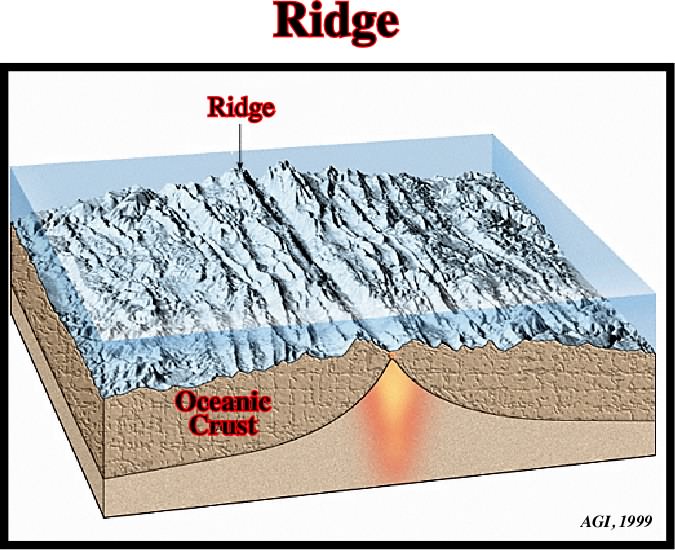
Contrariwise to the subaerial volcanic crust, the ridges forming the oceanic crust have a linear geometry, in surface, and in section a vertical geometry. Indeed, they are are the result of the agglutination the sheet dikes. Subsequently, the associated magnetic anomalies are quite obvious.
Local compressional tectonic regime created or associated by sea floor spreading.
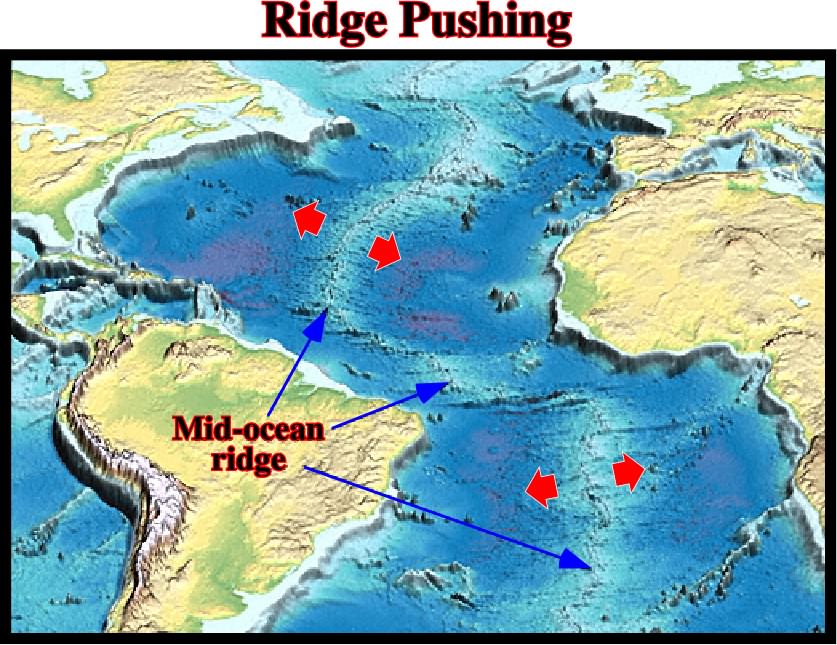
Fold-belts located in ultra deepwater, and particularly those having a landward vergence, have been explained by ridge push forces.
Synkinematic synform depocenter located around salt domes.

Rim synclines located around salt domes created very often turtle back structure (inversion) or apparent turtle back (without inversion) as illustrated.
See: Salt source layer.
Roho (Diegel, F. A. et al, 1995)
Synonym of Tertiary Salt Weld. Diegel et al. (1995), in Plio-Pleistocene detachment province of Gulf Coast, restricted the term roho to the characteristic discontinuous, high-amplitude seismic reflections caused by remnant salt along salt welds. Roho are also called salt evacuation surfaces or salt withdrawal surfaces.
See: Roho System.
Salt induced growth faults looking seaward (Gulf of Mexico). During a progradational loading, allochthonous salt can evacuated in different ways and given two quite different end-members. One with growth faults looking seaward, roho system, and another, with growth-faults looking landward, known as counter-regional system.
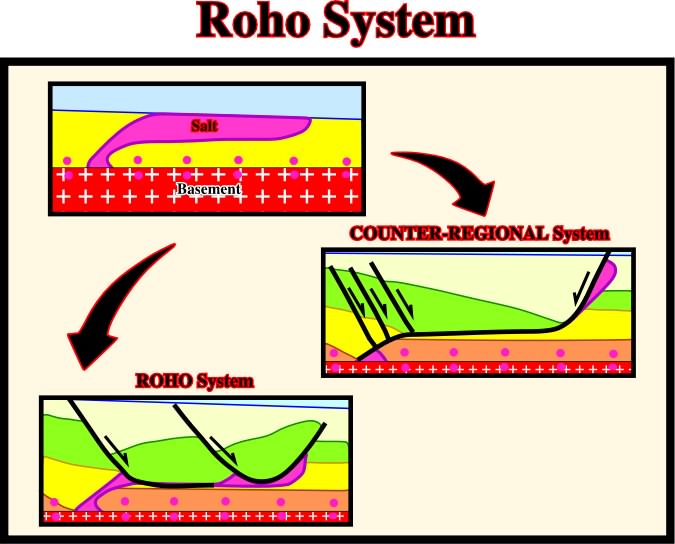
Schematic cross-section showing an allochthonous salt sheet and its ultimate evolution, following depositional loading and salt evacuation, into two end-member structural systems: (i) a stepped counter-regional system, consisting of a large growth fault looking landward, and (ii) a roho system, dominated by a major growth faults looking seaward soling into evacuated salt.
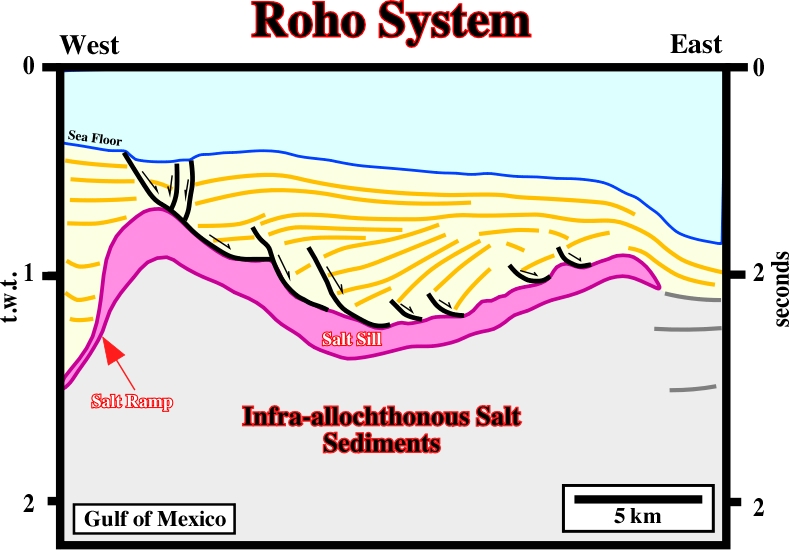
The partial evacuation of the allochthonous salt created successive depocenters, in the overlying sediments, which are limited by a series a growth-faults looking seaward. Such a fault system is call by geologist, particularly those working in the Gulf of Mexico, as a Roho system.
Name given by some geologists to the zone where pre-raft structures, with associated rollers, are the predominant salt structures. Typically these zones form the up-dip zones of the divergent salt margins such as the West Africa, Brazil, West Yemen, etc.
Base of a diapir stem.